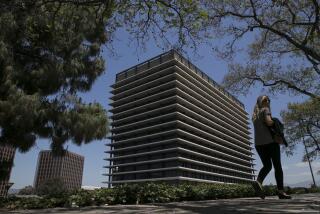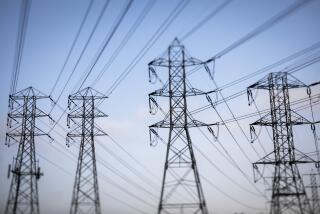A long wait to go solar
Asa Lantz never thought going green would involve so much red tape.
The 48-year-old wanted to slash her utility bill and help the environment by putting solar panels on the roof of her one-story Van Nuys home. The Los Angeles Department of Water and Power promised her system would be hooked up within three months after it was approved in September.
She’s still waiting.
Lantz is one of many Angelenos who complain of excessive delays and bureaucratic run-arounds when trying to get solar panels hooked to the electric grid. The problems are exasperating consumers, and some solar companies avoid doing business in the city.
It takes L.A. at least 12 to 13 weeks to approve and inspect rooftop panels for homeowners, according to estimates provided by the DWP. That’s roughly five times what it takes in San Diego and Sacramento.
“Los Angeles is almost a desert when it comes to solar,” said Bernadette Del Chiaro, executive director of the California Solar Energy Industries Assn. “The city has traditionally not been friendly.”
DWP acknowledges that it needs to streamline the process to reduce waiting time.
Americans are rushing to embrace solar power, especially as it has become more affordable. Many states offer tax breaks and rebates that can bring the cost of solar-panel system for a typical home down to $10,000 to $12,000. That cost has dropped about 50% since 2006.
Another big boost to the industry: Many companies install panels for virtually nothing and sell the energy generated to homeowners at cheaper rates than utilities.
A new solar project was installed every four minutes in the U.S. last year, according to data and advisory firm GTM Research. That’s up from one every 79 minutes in 2006, and researchers project it could increase to one every 80 seconds in a couple of years.
California is the nation’s largest market for solar because of year-round sunshine and statewide efforts to encourage green energy. The industry drives about $2.6 billion into the economy, according to the Solar Energy Industries Assn.
The state’s utilities have scrambled to keep up with the explosive growth — but the DWP has been particularly hard-pressed.
In Los Angeles, someone wanting to install panels is required to enroll in the city’s solar incentive program, which provides money for residents to go green. It takes 10 weeks from application to approval.
The homeowner next needs to obtain a building permit and set up an initial inspection of the home. This process takes about two days, according to the city’s Building and Safety Department.
Solar companies are then allowed to begin the installation. Once completed, a DWP inspector is required to check the system and install a new meter. The DWP said this process will take two to three weeks.
All told, the process could take as long as 13 weeks to complete. That doesn’t include the time it takes to actually install the panels, which can take a few days.
The main difference between the DWP and many other utilities is that they don’t require applicants to enroll in an incentive program.
San Diego permits and sends an inspector within 11 days, followed by a five-day wait for approval from San Diego Gas & Electric. The Sacramento Municipal Utility District gets homeowners through its process in 10 to 14 days, and many areas under its jurisdiction issue same-day building permits.
Other regions have made a concerted effort to improve their solar process. In September, nine Northern California cities banded together to develop a standardized process that cuts the wait time for permits to days at most.
Other utilities have also offered richer incentives compared with the L.A. DWP, Del Chiaro said.
Through a practice known as net metering, for example, power companies cut energy bills for customers who generate excess electricity from their panels and sell it back to the grid. California mandates that all utilities pay their customers retail price for this power. But the DWP received an exception and can pay lower rates. Del Chiaro said the DWP also takes longer to pay out rebates.
Michael Webster, assistant director of power system planning and development at the DWP, said delays in the solar program are due in part to staff turnover. New employees are currently being trained. Once they start working, he said, the process should get faster.
But he says that the DWP is looking for ways to reduce the number of steps a homeowner must go through to get approved.
“The L.A. DWP is clearly aware we are not meeting the service level,” he said. “We are doing what we can from a staffing perspective. But it’s not just about staffing. We want to evaluate the process and figure out ways to streamline, possibly eliminating [steps] to make sure the process flows faster.”
Webster said it is ultimately up to the DWP to figure out a way to handle the huge influx in solar applications.
Los Angeles handles a larger — and ever-growing — volume of applications from homeowners compared with many other cities. Last year, it processed about 4,300 residential applications, more than double the number in 2010. Pasadena, in comparison, handled about 100 last year.
By comparison, Southern California Edison handled nearly six times the volume of DWP last year, and its solar process takes three to nine weeks, according to SCE. The biggest utility in the Southland serves about 200 cities and municipalities.
Utilities are under pressure to encourage solar after Gov. Jerry Brown signed a law requiring that California get 33% of its electricity from renewable sources by 2020.
Lantz has started regretting her decision to go solar.
She was looking forward to saving about $50 a month on her utility bill, but now thinks that may never happen. Lantz suffered a setback when the DWP objected to some wording in the fine print of her contract after it had already been approved. She was just one of more than 1,000 customers that had to sign an amended contract that added further delays.
“Every time they are on their way, the DWP sends another agreement they need signed because they want to change three sentences,” she said. “They’re like the Mafia. They do whatever they want, and you can’t control them or speed them up.”
The DWP blames the city’s Department of Building and Safety, which never confirmed that Lantz had received a building permit for her system. The utility said the paperwork may be lost or the department may never have inspected her house.
“We’re thinking it’s Building and Safety,” Webster said.
DWP’s woes have attracted the attention of Mayor Eric Garcetti, who made overhauling the utility a central issue in his campaign. Garcetti spokeswoman Vicki Curry said the mayor was committed to improving solar in the city.
“This process simply takes too long,” she said. “We’re going to ensure the process to get solar power is as fast and convenient as possible for both residential and commercial projects.”
That can’t come soon enough for many solar installation companies.
The bureaucracy and slow processing times at L.A.’s utility has discouraged some solar firms from doing business in the city.
Torrance-based Verengo Solar, for one, doesn’t spend too much time in Los Angeles. Verengo President Ken Button, along with the company’s partner, Sunrun, is still fuming after the DWP demanded changes last year on hundreds of customer contracts the utility had already approved.
Dozens of their clients, like Lantz, are still stuck in paperwork limbo.
“We would love to be doing a lot of solar in L.A.,” Button said. “Unfortunately it’s not a prime focus for us. The economics are not great because the process is harder and more expensive.”
Kady Cooper, a spokeswoman with Vivint Solar, points out that Southland cities like Thousand Oaks are attractive to solar installers.
Many homeowners in this well-to-do city 40 miles west of L.A. say they are bombarded with mail, phone calls and knocks on the door from solar firms. City officials say the solar permit process takes four to six days, and then Southern California Edison takes over to hook panels up to the grid.
So Vivint has blanketed the city with salesmen in corporate T-shirts who try to charm homeowners into going green.
And, unlike Los Angeles residents, the homeowners there are overwhelmed with a little too much love from the solar industry.
Dan Laubscher, a California Highway Patrol officer, is fed up with constant solar come-ons. He’s now resorted to greeting unknown phone numbers with “Domino’s Pizza, will that be takeout or delivery?”
“They get confused and hang up,” he said with satisfaction. But “we still get six to 12 calls a day.”
Twitter: @ByShanLi
More to Read
Inside the business of entertainment
The Wide Shot brings you news, analysis and insights on everything from streaming wars to production — and what it all means for the future.
You may occasionally receive promotional content from the Los Angeles Times.











